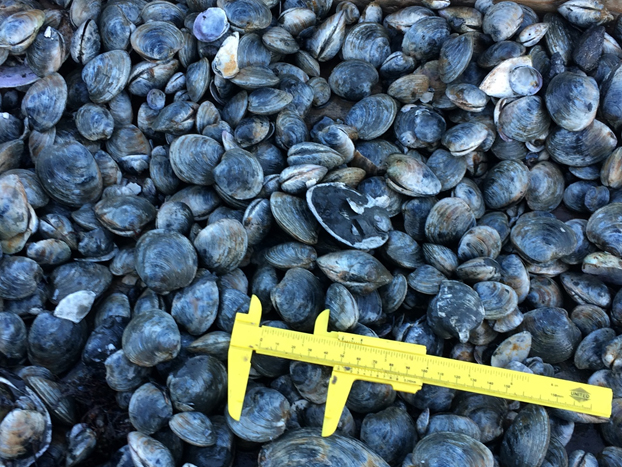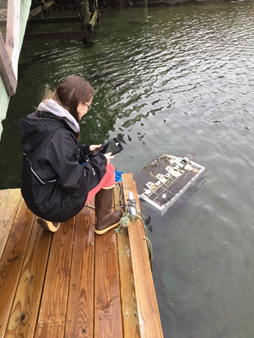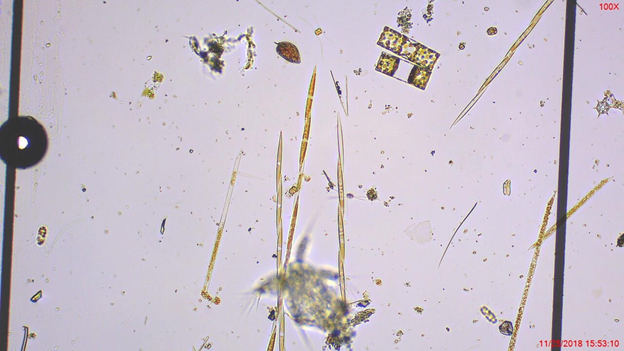Index
- ASP in Maine
- Shellfish Dealer Certification
- Quahog Survey
- Digital Tools Streamline Monitoring
- Rainfall Data Collection Improves
ASP in Maine: Past, Present, and Future
By Ari Leach, DMR Biotoxin Specialist
Maine has a long history of monitoring harmful algae that impact the state's shellfish industry. In 1996 the Marine Biotoxin Monitoring Program run by the Department of Marine Resources began tracking the harmful algae Pseudo-nitzschia, a genus of pennate diatoms which range in size and toxicity responsible for the production of the biotoxin domoic acid, which can cause Amnesic Shellfish Poisoning (ASP) including such symptoms as memory loss, brain damage and in extreme cases, death in humans. While Pseudo-nitzschia (PN) has been present in Maine's waters since monitoring began, the first toxic shellfish scores occurred in 2016, with scores jumping from no toxicity in early September to over the regulatory quarantine limit in late September. This prompted a shellfish harvesting closure of nearly all of eastern Maine and a recall of one week of blue mussel harvest, one lot of quahogs that had been contained in wet storage, and three days of softshell clam harvest. In total, nearly 11,000 lbs. of shellfish were impacted, with 96% of product recovered and destroyed. There were no reported illnesses.
Since the high shellfish scores in late September of 2016, Maine has seen fluctuating shellfish scores and PN concentrations. In 2017, water samples from up and down the coast showed elevated numbers of PN, but no toxicity in shellfish throughout the summer. However, in September there was a shift in the composition of the bloom from being dominated by small cell to large cell varieties, which resulted in shellfish scores over the quarantine limit. This caused a portion of eastern Maine to close for shellfish harvesting. DMR also recalled five days of blue mussel harvest totaling 58,480 lbs., 98% of which was successfully recovered and destroyed. Again, there were no reported illnesses.
The 2017 closure that resulted from high shellfish scores lasted from September until early October in the Frenchman Bay region, with smaller precautionary closures lasting into early December of 2017. However, Maine hadn't seen the last of PN for the winter. A relatively large bloom of PN occurred in Casco Bay, comprised of mostly large cells, extending the shellfish harvesting closure through mid-January. This extension of the harvesting closure led to DMR staff collaborating with local shellfish wardens to collect shellfish and water samples from an increased number of sites in and around Casco Bay. With the help of the wardens, DMR could carefully monitor the bloom and reopen harvest areas.
DMR collaborated with other laboratories to understand what caused the blooms of 2016 and 2017 to be so toxic and determined that a new species, Pseudo-nitschia australis, had entered the Gulf of Maine. How it came to be in our waters is still a topic of debate. This species is large for its genus and can be toxic at low concentrations. DMR now watches for the shift in bloom composition from small to large cell as an additional early warning that a PN bloom may be becoming toxic. Collaboration with other laboratories is ongoing in working to develop new technologies to more rapidly determine the species contained within a bloom.
In 2018, DMR held an ASP conference to provide information and improve understanding of the occurrence and management of ASP in Maine. The conference included presentations on direct toxin detection, reasons for ASP occurrences in Maine, challenges and successes in monitoring for ASP, the usage of short-term precautionary closures, and continued research and management strategies for the future.
With the 2019 ASP season fast approaching, DMR and a network of volunteer partners are gearing up for increased phytoplankton and shellfish sampling, including the use of traps to hold shellfish for testing in areas of low resource. These traps allow DMR field staff to quickly and efficiently collect shellfish resources in areas that have experienced resource decline, or that have historically low availability of shellfish. Inter-laboratory collaborations, innovative phytoplankton monitoring strategies, precautionary closures, shellfish traps, additional phytoplankton monitoring volunteers, and shellfish warden participation are all resources being utilized to closely monitor PN and work to keep important shellfish harvesting areas open for business.
Shellfish Dealer Certifications and Renewals
By DMR Seafood Inspection Supervisor John Fendl
We made it through another year of renewals of Certified Dealers and it went well for the most part. There is still some confusion about the difference between the Wholesale Seafood (with or without lobster) License and the Sanitation Certificate, which are the Shellstock Shipper, Shucker Packer, Reshipper, or Depuration Processor certificates. These are two separate things, but you can not hold a certification without a Wholesale Seafood license. The license and the certificate have different expiration dates which can make it hard to keep up with. Set reminders on your electronic calendar to keep up with the different expiration dates and you will never be out of compliance! The Wholesale Seafood License expires March 31st of every year and the Sanitation Certificate expires May 31st. Best to think of this as the same as your personal vehicle, you have both a registration and an inspection to keep up with. Both have different expiration dates and it's up to you to keep up with both. To make it easier, we have changed the date for the earliest you can get into LEEDS and renew your licenses and certifications. You can now renew any time after February 1st of each year.
When you pay for your Wholesale Seafood License you get it as soon as it's paid for. When you pay for your Sanitation Certificate it goes into a "Pending Inspection" status. That alerts the Inspection Team that you are ready for another year of dealer certification. Of course, that requires an inspection of your facility and once the recertification inspection is complete we will email your Sanitation Certificate to you.
Some LEEDS tips:
-it's very important that you know the difference between renewing a license and applying for a new license. When you renew, you will be shown the licenses you held last year, and you have the option to renew with the same license numbers. If you apply for anything new you will be assigned a new license number. This is particularly important when you have a certification number, let's say ME 1 SS and you apply for a new license, you will get assigned a new number something like ME 12456 SS. that's not good.
-Remember that there is now a fee for the Sanitation Certificates. We used to include the certificates in the cost of the Wholesale Seafood license but as of last year and going forward you now pay a fee to get that certificate activated in the LEEDS system.
Have a good summer and as always, call me if you have questions or issues. John Fendl, Dealer Inspection Supervisor: 207-592-8934.
2018 New Meadows Bullrake Quahog Survey
By Deni-Marc Nault, Program Supervisor

DMR has conducted seed quahog surveys in the Upper New Meadows Lake in 2011, 2012, 2013, 2015 and 2017. The Lower Pond was added in 2017. This survey was designed to assess the unusually high density of small quahogs. This survey worked very well capturing quahogs in the 7mm -19mm (1/4 inch 3/4 inch) size range. In 2015, DMR observed a significant drop-off in that size range and a shift in size to the 25mm to 41mm (1 inch - 1 3/4 inch) range. The 2017 survey showed the return of the smaller seed quahogs but also a second bump in the just sublegal size.
During a stakeholder meeting DMR recognized we were not accurately capturing this upper size range. DMR biologist Denis Nault went out on the upper pond with a harvester and observed the huge concentration of just sublegal quahogs in some areas. These quahogs were so dense, competition for food was limiting growth to harvestable size. That winter a bullrake survey was designed to capture this missing data.
In August 2019 with the assistance of two New Meadows harvesters DMR conducted a bullrake survey. The bullrakes were lined with 1/2 inch galvanized hardware cloth. Fifty randomly selected samples were collected from numbered grids we used from the original seed quahog survey. The harvesters raked for 30 seconds which gave us an area of approximately 1.5 square meters. This survey yielded a more accurate map of where the highest density of sublegal quahogs were located.
This has given DMR the data to develop a plan to transplant these sublegal quahogs. Moving the quahogs from high densities to lower concentrated areas within the upper pond should get the quahogs to grow quicker to legal size. This summer with the help of quahog harvesters on the pond DMR is moving sublegal quahogs around the upper pond with that goal.
Digital Data Collection Tools Help Streamline Biotoxin Monitoring

Maine DMR's Marine Biotoxin Monitoring program has recently adopted digital data collection methods in the West Boothbay Harbor office. Using the digital data collection interface iForm Builder, Boothbay Harbor Laboratory staff have designed a data collection tool for shellfish and phytoplankton samples in the field and lab. This new tool has allowed staff to replace nearly all paper forms used in the Boothbay office.
Field staff enter date, time, shellfish species, and capture GPS data for the location of samples that are collected. Seawater samples collected to monitor for the presence of phytoplankton species that create toxins are tracked and the results from microscopic inspection of the samples are recorded in the iForm app. Shellfish collection is tracked from the field to sample preparation for High Performance Liquid Chromatography (HPLC) analysis for various biotoxins. The data is seamlessly uploaded to our server and used to track sample collection and processing, which allows for easier and more timely scheduling updates during the busy red tide season.
This new data collection method has streamlined the biotoxin program at the Boothbay Harbor office as well as greatly reduced paper waste and storage. DMR Staff hope to expand this tool to other parts of the Public Health lab, including the water quality program, storage and tracking of chemicals, and other field scheduling and communication.
Rainfall Data Collection Improves
Rainfall is a significant contributor to non-point source bacterial loading that impacts water quality in shellfish growing areas throughout coastal Maine. In response, the Maine Department of Marine Resources (DMR) uses rainfall event totals to make shellfish harvest area closure and reopening decisions. For instance, DMR will close harvesting in coastal areas when rainfall totals reach two inches or greater within 24 hours or following a continuous storm event. When made, this closure is referred to as an Area No. 500 flood closure. DMR also uses local rainfall totals to determine if bacterial pollution in certain sensitive areas is caused by one-inch rainfall events. Some of those areas may have shortened defined closures managed by rainfall instead of the more limited harvests associated with seasonal Conditionally Approved or Restricted classifications.
DMR monitors rainfall totals at representative coastal locations using data collected by the website Weather Underground (www.wunderground.com). Volunteer locations transmit real-time rainfall and weather data through the Weather Underground portal which is then available for public view. The reporting locations are generally private weather stations owned by individuals or organizations that need 24/7 internet connections. Coverage within a given geographic area is limited by the number of reporting participants and prior to 2016, Washington County had few partners with reliable rainfall reporting. Because of this minimal rain gauge density DMR rainfall closure decisions were based on sparse data that did not always accurately reflect more localized conditions. This situation may have led to rainfall closures larger than necessary or closures not occurring at impacted locations. It may have also led to DMR unwittingly collecting routine random water samples when the area should have been included in a flood closure. Results from those samples would then be entered in the water quality classification database and used in the P90 calculation that classifies shellfish harvest areas. Generally sample results used in classification calculations persist for five years and results from samples collected during an undetected flood event may lead to an inaccurate classification of a harvest location. Following a flood closure, DMR routinely samples waters within the closed areas and only uses those results to determine if water quality has returned to approved standards. Results of samples collected in association with flood closures are not used in shellfish harvest area classification calculations.
To facilitate the inadequate rain gauge placement, DMR collaborated with the Washington County Council of Governments (WCCG) in 2015 to identify rainfall coverage gaps in Washington County. With the gap locations were identified, WCCG applied for a Coastal Community Grant to fund rain gauge purchases through the Maine Coastal Program (http://www.wccog.net/rain-gauges.htm). Once the proposal was accepted and funded in 2016, WCCG identified volunteer cooperators and DMR installed the gauges resulting in placement of gauges in ten Washington County communities. Since that initial success, DMR has identified additional rain gauge coverage gaps along the entire Maine coast and in 2019, received funding from the Maine Coastal Program to purchase an additional eight gauges. Throughout the summer and fall DMR will begin working with volunteer cooperators to place the rain gauge units at strategic locations providing valuable rainfall data that strengthen the DMR shellfish program responses to episodic rainfall events.
